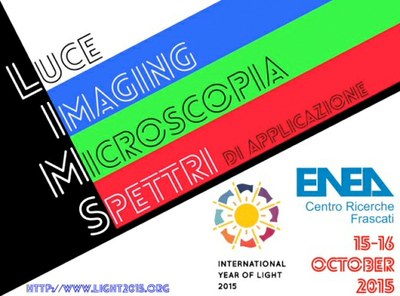Innovation technology: Photonics, a new frontier in light
5/11/2015
The event “LIMS 2015” – Light, Imaging, Microscopy, Spectra of Applications” - held at the Enea Frascati Research Center on the occasion of the International Year of Light and Light-based Technologies, has brought together leading experts and researchers to discuss the latest developments in photonics, a science with a tremendous potential to profoundly impact our everyday life and provide solutions to worldwide challenges in areas such as the environment, energy and health.
 The Conference highlighted the latest research on light-based technologies in sectors ranging from microscopy to sensoristics with applications to the biomedical field, to new technologies for diagnostic imaging, from lasers for materials and industrial applications to new trends in illumination, photovoltaics and the cultural heritage.
The Conference highlighted the latest research on light-based technologies in sectors ranging from microscopy to sensoristics with applications to the biomedical field, to new technologies for diagnostic imaging, from lasers for materials and industrial applications to new trends in illumination, photovoltaics and the cultural heritage.
But optical technologies provide solutions beyond everyday life, to involve space and hostile environments such as Antarctica.
Among the LIMS 2015 state-of-the-art technologies ENEA presented innovative radiation solid state detectors based on crystals and salts allowing to “see” and measure proton beams utilized in hadron therapy, the most advanced radiotherapy available to treat cancer.
In the future this innovation will extend our ability to target cancer more accurately and reduce exposure time.
One of the most promising features of these luminescent detectors is the capability to visualize directly the energy deposited by the proton beam by means of a simple optical fluorescent microscope.
This makes it possible to characterize and measure the profile of the beam of protons in relation to the depth of penetration, similarly to what happens in the human tissue during hadron therapy.
“Thanks to this property, also defined tissue equivalence, for the first time we have been able to provide a quantitative mapping of the local doses deposited by protons” Rosa Maria Montereali at ENEA affirms. “This is the reason why the detector is considered a promising dosimeter.
The results of the ENEA research are spreading around the world and have been published in “Applied Physics Letters”, an American journal featuring reports on the latest findings in applied physics, with an impact factor over three (see References).
Photonics, a key enabling technology under the European program Horizon 2020 for funding allocated, is considered strategically crucial to set Europe ahead of international competition and foster industrial innovation through development and know-how transfer.
LIMS 2015 is carried out under the auspices of Società Italiana di Fisica (SIF), Società Italiana di Ottica e Fotonica (SIOF), European Photonics Industry Consortium (EPIC), Rome University “La Sapienza” and Roma Tre, the INFN-LNF and the CNR.
For more information please contact:
Rosa Maria Montereali, ENEA Frascati Research Center, rosa.montereali@enea.it
To get more information on the program log on to:
http://www.frascati.enea.it/LIMS2015/
http://www.frascati.enea.it/UTAPRAD/lab_mnf.htm
“Photoluminescence of radiation-induced color centers in lithium fluoride thin films for advanced diagnostics of proton beams” (M. Piccinini, F. Ambrosini, A. Ampollini, L. Picardi, C. Ronsivalle, F. Bonfigli, S. Libera, E. Nichelatti, M. A. Vincenti, R. M. Montereali) Appl. Phys. Lett. 106, 261108 (2015)
